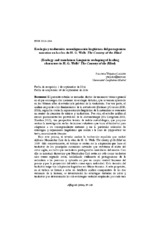Mostrar el registro sencillo del ítem
Ecología y traducción: reconfiguración lingüística del protagonista narrativo en la obra de H. G. Wells The Country of the Blind
| dc.contributor.author | Tejada Caller, Paloma | |
| dc.date.accessioned | 2017-01-13T11:12:31Z | |
| dc.date.available | 2017-01-13T11:12:31Z | |
| dc.date.issued | 2016 | |
| dc.identifier.issn | 2386-9658 | |
| dc.identifier.uri | http://hdl.handle.net/10396/14292 | |
| dc.description.abstract | El presente estudio se encuadra dentro de un marco teórico general en el que convergen dos nociones de ecología distintas, que se vienen aplicando en los últimos años al estudio y la práctica de la traducción. Por una parte, el análisis responde a los fundamentos de la ecotraducción (Badenes y Coisson 2010; 2015), según los cuales la representación lingüística de la naturaleza se convierte en centro de atención de críticos y traductores. Por otra, el estudio ratifica al menos parcialmente los postulados de la eco-translatología (Hu Gengshen 2003; Xiaohua 2015), una perspectiva teórica de índole metodológica, que propone centrar la investigación en las decisiones subjetivas que toma el traductor para adaptarse a su correspondiente entorno y en la particular selección de estrategias y expresiones lingüísticas que realiza a la hora de (re)producir un texto, normalmente literario. Bajo este prisma, el estudio analiza la traducción española que realizó Alfonso Hernández Catá de la obra de H. G. Wells The Country of the Blind en 1919. Más concretamente, el trabajo se centra en la adaptación que hace el traductor de los principales escenarios naturales que vertebran el relato del autor inglés, en tanto que verdaderos protagonistas simbólicos del mismo. Con ello se intentará demostrar que Hernández Catá actúa no sólo como traductor sino como segundo autor, trasladando sutilmente el protagonismo de la naturaleza a las personas y optando así por un mayor control humano del paisaje y por la proyección del relato como épica individual. Esta decisión del traductor exige una adaptación lingüística en último término. A este propósito, en el trabajo se llevará a cabo un detallado análisis comparativo de las dos versiones de la historia; se determinarán las estrategias textuales de autor y traductor y se determinarán las sub-estrategias verbales empleadas por cada uno para lograr sus objetivos. Particular atención recibirán los mecanismos de cohesión léxica y gramatical, como son la referencia anafórica, la repetición léxica y las estructuras combinatorias utilizadas para la construcción de los dos mundos wellsianos, así como las distintas tácticas lingüísticas utilizadas por el traductor para incrementar los índices de subjetividad en la narración española. | es_ES |
| dc.description.abstract | This paper is part of a general theoretical framework which draws from two different notions of ecology: ecotranslation and eco-translatology. Ecotranslation (Badenes and Coisson 2010; 2015) refers to the practice, by critics and translators, of making the linguistic representation of nature their main focus. Eco-translatology (Hu Gengshen 2003; Xiaohua 2015) is a theoretical methodology according to which the research should focus on, first, subjective decisions taken by the translator in order to adapt to the translator‘s own environment and, second, their particular choice of strategies and linguistic expressions used to (re)produce a (normally literary) text. Over the past few years, these two notions have been applied to translation, both in theory and in practice. The present study draws from the principles of ecotranslation, and (at least partially) confirms the postulates of eco-translatology. From this perspective, this paper will analyse the 1919 Spanish translation of H. G. Wells‘ The Country of the Blind by Alfonso Hernández Catá. In particular, the paper tackles the translator‘s adaptation of the main natural settings present in the original work, which can be said to be the symbolic protagonists of this work. With this, it will be shown that Hernández Catá is not merely a translator, but a second author, in his subtle transferral of the focus from nature to people. With this transferral, the translator displays a greater human control and turns the original story into a heroic tale. And, ultimately, this transferral forces a linguistic adaptation. Indeed, this is what this paper will focus on. The paper will put forward a detailed comparative analysis of the original and translated versions of the work. This analysis will help determine the textual strategies and verbal sub-strategies used by the author, on the one hand, and the translator, on the other, to each achieve their goals. | es_ES |
| dc.format.mimetype | application/pdf | es_ES |
| dc.language.iso | spa | es_ES |
| dc.publisher | UCOPress | es_ES |
| dc.rights | https://creativecommons.org/licenses/by/3.0/ | es_ES |
| dc.source | Alfinge 28, 89-108 (2016) | es_ES |
| dc.subject | Traducción | es_ES |
| dc.subject | Ecología | es_ES |
| dc.subject | Ecotraducción | es_ES |
| dc.subject | Reconfiguración lingüística | es_ES |
| dc.subject | Wells, H. G. 1866-1946 | es_ES |
| dc.subject | The Country of the Blind | es_ES |
| dc.subject | Translation | es_ES |
| dc.subject | Ecology | es_ES |
| dc.subject | Ecotranslation | es_ES |
| dc.subject | Linguistic reshaping | es_ES |
| dc.title | Ecología y traducción: reconfiguración lingüística del protagonista narrativo en la obra de H. G. Wells The Country of the Blind | es_ES |
| dc.title.alternative | Ecology and translation: Linguistic reshaping of leading characters in H. G. Wells’ The Country of the Blind | es_ES |
| dc.type | info:eu-repo/semantics/article | es_ES |
| dc.relation.publisherversion | https://www.uco.es/ucopress/ojs/index.php/alfinge/index | es_ES |
| dc.rights.accessRights | info:eu-repo/semantics/openAccess | es_ES |

